Critical Analysis: The American Dream in Lorraine Hansberry's Play
VerifiedAdded on 2023/01/17
|8
|2199
|81
Essay
AI Summary
This essay delves into Lorraine Hansberry's play, "A Raisin in the Sun," examining the multifaceted depiction of the American Dream within the context of race, class, and gender. The essay begins with a plot summary of the play, focusing on the Younger family's struggles and aspirations. It then explores the concept of the American Dream, contrasting Walter's materialistic vision with his mother's values, and analyzing how individual identities are shaped by societal constraints. The essay further investigates the roles of women in the play and how their experiences are influenced by gender conditioning. Through detailed analysis, the essay highlights the challenges faced by the Younger family as they strive to achieve their dreams amidst poverty and societal barriers, ultimately revealing the complex and often contradictory nature of the American Dream for African Americans in the mid-20th century. The essay incorporates secondary sources to support its arguments and provide a comprehensive understanding of the play's themes.
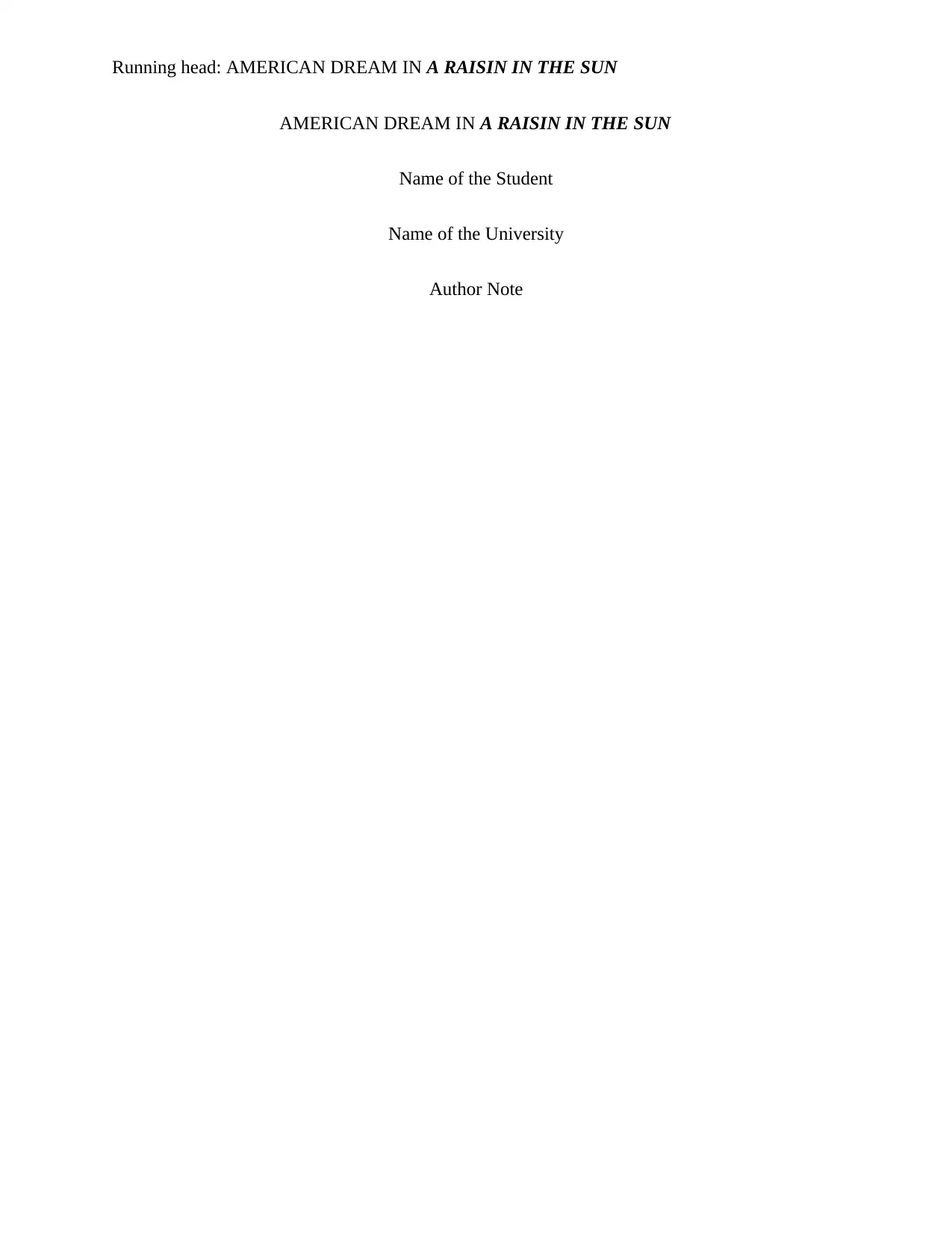
Running head: AMERICAN DREAM IN A RAISIN IN THE SUN
AMERICAN DREAM IN A RAISIN IN THE SUN
Name of the Student
Name of the University
Author Note
AMERICAN DREAM IN A RAISIN IN THE SUN
Name of the Student
Name of the University
Author Note
Paraphrase This Document
Need a fresh take? Get an instant paraphrase of this document with our AI Paraphraser
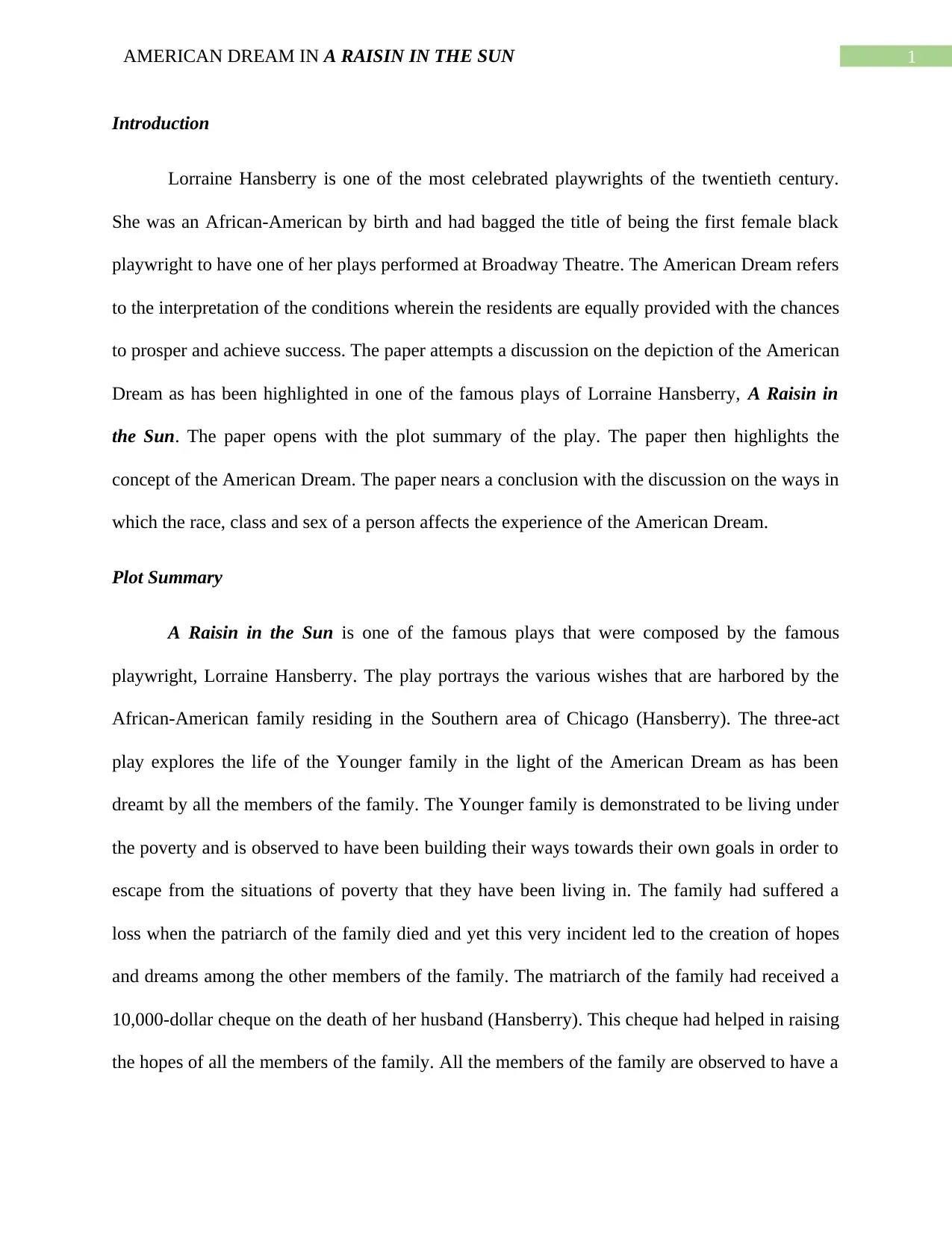
1AMERICAN DREAM IN A RAISIN IN THE SUN
Introduction
Lorraine Hansberry is one of the most celebrated playwrights of the twentieth century.
She was an African-American by birth and had bagged the title of being the first female black
playwright to have one of her plays performed at Broadway Theatre. The American Dream refers
to the interpretation of the conditions wherein the residents are equally provided with the chances
to prosper and achieve success. The paper attempts a discussion on the depiction of the American
Dream as has been highlighted in one of the famous plays of Lorraine Hansberry, A Raisin in
the Sun. The paper opens with the plot summary of the play. The paper then highlights the
concept of the American Dream. The paper nears a conclusion with the discussion on the ways in
which the race, class and sex of a person affects the experience of the American Dream.
Plot Summary
A Raisin in the Sun is one of the famous plays that were composed by the famous
playwright, Lorraine Hansberry. The play portrays the various wishes that are harbored by the
African-American family residing in the Southern area of Chicago (Hansberry). The three-act
play explores the life of the Younger family in the light of the American Dream as has been
dreamt by all the members of the family. The Younger family is demonstrated to be living under
the poverty and is observed to have been building their ways towards their own goals in order to
escape from the situations of poverty that they have been living in. The family had suffered a
loss when the patriarch of the family died and yet this very incident led to the creation of hopes
and dreams among the other members of the family. The matriarch of the family had received a
10,000-dollar cheque on the death of her husband (Hansberry). This cheque had helped in raising
the hopes of all the members of the family. All the members of the family are observed to have a
Introduction
Lorraine Hansberry is one of the most celebrated playwrights of the twentieth century.
She was an African-American by birth and had bagged the title of being the first female black
playwright to have one of her plays performed at Broadway Theatre. The American Dream refers
to the interpretation of the conditions wherein the residents are equally provided with the chances
to prosper and achieve success. The paper attempts a discussion on the depiction of the American
Dream as has been highlighted in one of the famous plays of Lorraine Hansberry, A Raisin in
the Sun. The paper opens with the plot summary of the play. The paper then highlights the
concept of the American Dream. The paper nears a conclusion with the discussion on the ways in
which the race, class and sex of a person affects the experience of the American Dream.
Plot Summary
A Raisin in the Sun is one of the famous plays that were composed by the famous
playwright, Lorraine Hansberry. The play portrays the various wishes that are harbored by the
African-American family residing in the Southern area of Chicago (Hansberry). The three-act
play explores the life of the Younger family in the light of the American Dream as has been
dreamt by all the members of the family. The Younger family is demonstrated to be living under
the poverty and is observed to have been building their ways towards their own goals in order to
escape from the situations of poverty that they have been living in. The family had suffered a
loss when the patriarch of the family died and yet this very incident led to the creation of hopes
and dreams among the other members of the family. The matriarch of the family had received a
10,000-dollar cheque on the death of her husband (Hansberry). This cheque had helped in raising
the hopes of all the members of the family. All the members of the family are observed to have a
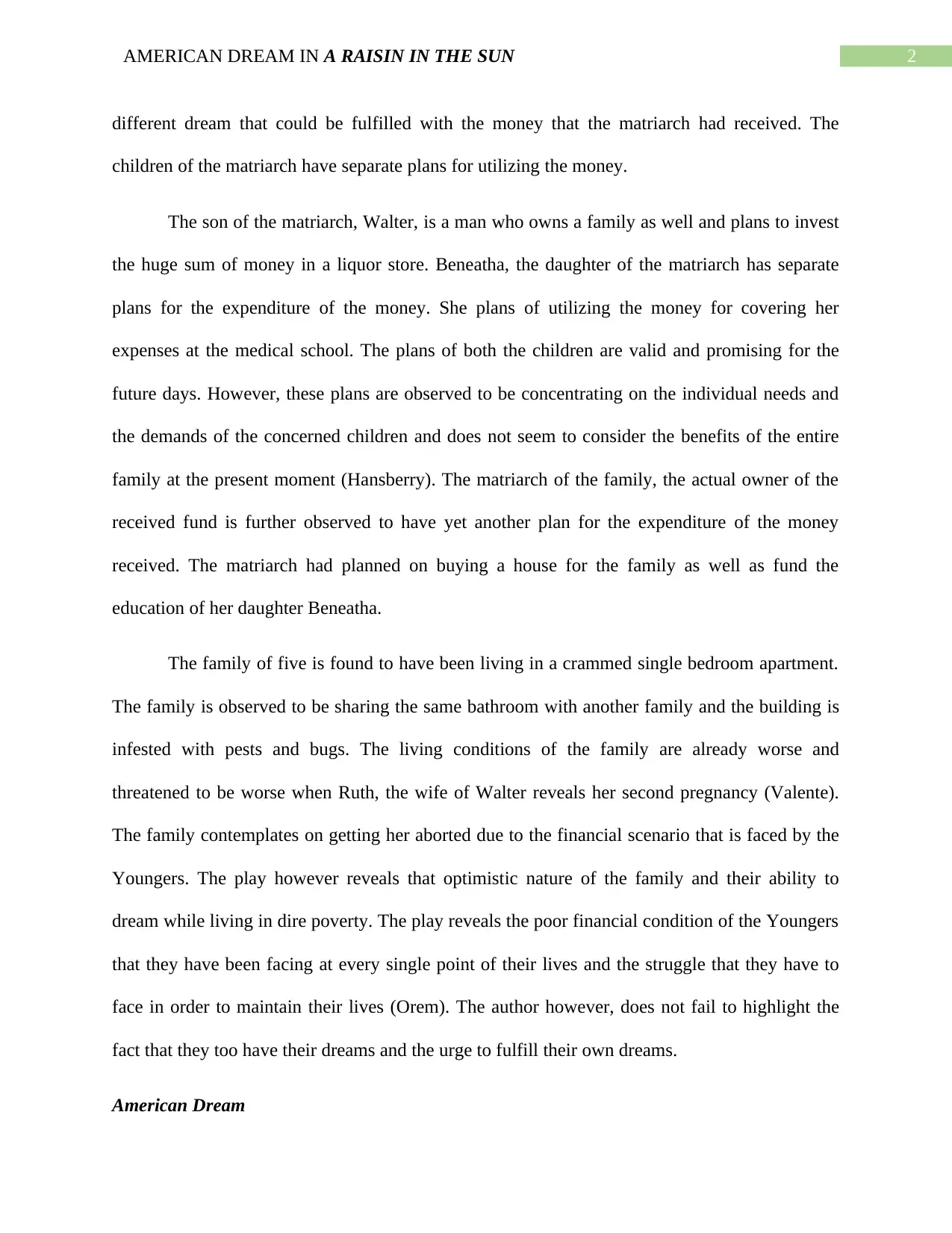
2AMERICAN DREAM IN A RAISIN IN THE SUN
different dream that could be fulfilled with the money that the matriarch had received. The
children of the matriarch have separate plans for utilizing the money.
The son of the matriarch, Walter, is a man who owns a family as well and plans to invest
the huge sum of money in a liquor store. Beneatha, the daughter of the matriarch has separate
plans for the expenditure of the money. She plans of utilizing the money for covering her
expenses at the medical school. The plans of both the children are valid and promising for the
future days. However, these plans are observed to be concentrating on the individual needs and
the demands of the concerned children and does not seem to consider the benefits of the entire
family at the present moment (Hansberry). The matriarch of the family, the actual owner of the
received fund is further observed to have yet another plan for the expenditure of the money
received. The matriarch had planned on buying a house for the family as well as fund the
education of her daughter Beneatha.
The family of five is found to have been living in a crammed single bedroom apartment.
The family is observed to be sharing the same bathroom with another family and the building is
infested with pests and bugs. The living conditions of the family are already worse and
threatened to be worse when Ruth, the wife of Walter reveals her second pregnancy (Valente).
The family contemplates on getting her aborted due to the financial scenario that is faced by the
Youngers. The play however reveals that optimistic nature of the family and their ability to
dream while living in dire poverty. The play reveals the poor financial condition of the Youngers
that they have been facing at every single point of their lives and the struggle that they have to
face in order to maintain their lives (Orem). The author however, does not fail to highlight the
fact that they too have their dreams and the urge to fulfill their own dreams.
American Dream
different dream that could be fulfilled with the money that the matriarch had received. The
children of the matriarch have separate plans for utilizing the money.
The son of the matriarch, Walter, is a man who owns a family as well and plans to invest
the huge sum of money in a liquor store. Beneatha, the daughter of the matriarch has separate
plans for the expenditure of the money. She plans of utilizing the money for covering her
expenses at the medical school. The plans of both the children are valid and promising for the
future days. However, these plans are observed to be concentrating on the individual needs and
the demands of the concerned children and does not seem to consider the benefits of the entire
family at the present moment (Hansberry). The matriarch of the family, the actual owner of the
received fund is further observed to have yet another plan for the expenditure of the money
received. The matriarch had planned on buying a house for the family as well as fund the
education of her daughter Beneatha.
The family of five is found to have been living in a crammed single bedroom apartment.
The family is observed to be sharing the same bathroom with another family and the building is
infested with pests and bugs. The living conditions of the family are already worse and
threatened to be worse when Ruth, the wife of Walter reveals her second pregnancy (Valente).
The family contemplates on getting her aborted due to the financial scenario that is faced by the
Youngers. The play however reveals that optimistic nature of the family and their ability to
dream while living in dire poverty. The play reveals the poor financial condition of the Youngers
that they have been facing at every single point of their lives and the struggle that they have to
face in order to maintain their lives (Orem). The author however, does not fail to highlight the
fact that they too have their dreams and the urge to fulfill their own dreams.
American Dream
⊘ This is a preview!⊘
Do you want full access?
Subscribe today to unlock all pages.

Trusted by 1+ million students worldwide
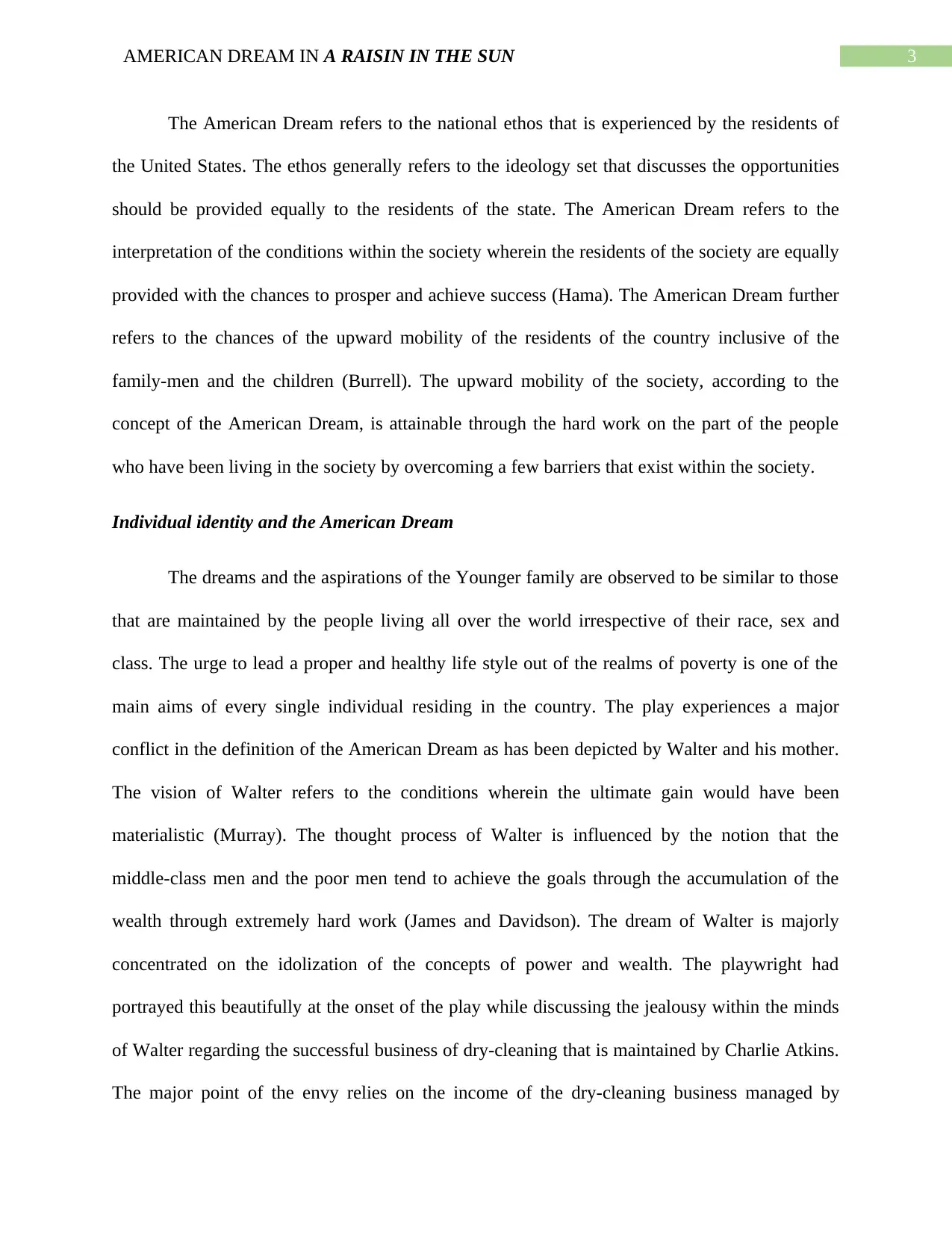
3AMERICAN DREAM IN A RAISIN IN THE SUN
The American Dream refers to the national ethos that is experienced by the residents of
the United States. The ethos generally refers to the ideology set that discusses the opportunities
should be provided equally to the residents of the state. The American Dream refers to the
interpretation of the conditions within the society wherein the residents of the society are equally
provided with the chances to prosper and achieve success (Hama). The American Dream further
refers to the chances of the upward mobility of the residents of the country inclusive of the
family-men and the children (Burrell). The upward mobility of the society, according to the
concept of the American Dream, is attainable through the hard work on the part of the people
who have been living in the society by overcoming a few barriers that exist within the society.
Individual identity and the American Dream
The dreams and the aspirations of the Younger family are observed to be similar to those
that are maintained by the people living all over the world irrespective of their race, sex and
class. The urge to lead a proper and healthy life style out of the realms of poverty is one of the
main aims of every single individual residing in the country. The play experiences a major
conflict in the definition of the American Dream as has been depicted by Walter and his mother.
The vision of Walter refers to the conditions wherein the ultimate gain would have been
materialistic (Murray). The thought process of Walter is influenced by the notion that the
middle-class men and the poor men tend to achieve the goals through the accumulation of the
wealth through extremely hard work (James and Davidson). The dream of Walter is majorly
concentrated on the idolization of the concepts of power and wealth. The playwright had
portrayed this beautifully at the onset of the play while discussing the jealousy within the minds
of Walter regarding the successful business of dry-cleaning that is maintained by Charlie Atkins.
The major point of the envy relies on the income of the dry-cleaning business managed by
The American Dream refers to the national ethos that is experienced by the residents of
the United States. The ethos generally refers to the ideology set that discusses the opportunities
should be provided equally to the residents of the state. The American Dream refers to the
interpretation of the conditions within the society wherein the residents of the society are equally
provided with the chances to prosper and achieve success (Hama). The American Dream further
refers to the chances of the upward mobility of the residents of the country inclusive of the
family-men and the children (Burrell). The upward mobility of the society, according to the
concept of the American Dream, is attainable through the hard work on the part of the people
who have been living in the society by overcoming a few barriers that exist within the society.
Individual identity and the American Dream
The dreams and the aspirations of the Younger family are observed to be similar to those
that are maintained by the people living all over the world irrespective of their race, sex and
class. The urge to lead a proper and healthy life style out of the realms of poverty is one of the
main aims of every single individual residing in the country. The play experiences a major
conflict in the definition of the American Dream as has been depicted by Walter and his mother.
The vision of Walter refers to the conditions wherein the ultimate gain would have been
materialistic (Murray). The thought process of Walter is influenced by the notion that the
middle-class men and the poor men tend to achieve the goals through the accumulation of the
wealth through extremely hard work (James and Davidson). The dream of Walter is majorly
concentrated on the idolization of the concepts of power and wealth. The playwright had
portrayed this beautifully at the onset of the play while discussing the jealousy within the minds
of Walter regarding the successful business of dry-cleaning that is maintained by Charlie Atkins.
The major point of the envy relies on the income of the dry-cleaning business managed by
Paraphrase This Document
Need a fresh take? Get an instant paraphrase of this document with our AI Paraphraser

4AMERICAN DREAM IN A RAISIN IN THE SUN
Atkins has a high gross turnover of around 100,000 dollars (King). Walter is observed to ignore
all the warnings of his wife Ruth. She had warned him against the fictitious nature of his
business partner. He is also observed to have been ignoring the requests of his mother, the
matriarch of the family against his proposal of owning a liquor shop. The matriarch is observed
to have been considering the act of owning a liquor shop to be an immoral activity. Walter
however is not deterred from his objective since he has been viewing the liquor store as one of
the major ways to achieve his goals (Thomas). The decision of Walter to accept the offer of Mr.
Lindner is another instance wherein the playwright demonstrates the implementation of the
Machiavellian spirit of Walter (Hansberry). Walter is depicted as a character who is highly
interested in the financial factors and the success of the people in the achievement of the goals
that have been set by them. The interpretation of Walter regarding the American Dream is highly
challenged by the playwright when he makes Walter carry out his transactions in front of his own
son. The American Dream is known to have been prioritizing the issues of equality and justice
over the concept of money.
The gender roles as demonstrated by the playwright discusses three types of women
within the play and the habits that have been demonstrated by them. The matriarch of the family
is observed to have been demonstrating the gender conditioning (McNeil and Fairley Jr.). The
matriarch is found to have been leading her life on the basis of the various activities that might
lead to betterment of the family in future. The wife of Walter on the other hand is observed to
have been vocalizing all her issues that have been affecting her with her husband (de Oliveira
and Medeiros). However, she tends to argue on behalf of her husband while discussing the
matters with the matriarch. Čerče argues that the matriarch’s daughter is known to have been a
Atkins has a high gross turnover of around 100,000 dollars (King). Walter is observed to ignore
all the warnings of his wife Ruth. She had warned him against the fictitious nature of his
business partner. He is also observed to have been ignoring the requests of his mother, the
matriarch of the family against his proposal of owning a liquor shop. The matriarch is observed
to have been considering the act of owning a liquor shop to be an immoral activity. Walter
however is not deterred from his objective since he has been viewing the liquor store as one of
the major ways to achieve his goals (Thomas). The decision of Walter to accept the offer of Mr.
Lindner is another instance wherein the playwright demonstrates the implementation of the
Machiavellian spirit of Walter (Hansberry). Walter is depicted as a character who is highly
interested in the financial factors and the success of the people in the achievement of the goals
that have been set by them. The interpretation of Walter regarding the American Dream is highly
challenged by the playwright when he makes Walter carry out his transactions in front of his own
son. The American Dream is known to have been prioritizing the issues of equality and justice
over the concept of money.
The gender roles as demonstrated by the playwright discusses three types of women
within the play and the habits that have been demonstrated by them. The matriarch of the family
is observed to have been demonstrating the gender conditioning (McNeil and Fairley Jr.). The
matriarch is found to have been leading her life on the basis of the various activities that might
lead to betterment of the family in future. The wife of Walter on the other hand is observed to
have been vocalizing all her issues that have been affecting her with her husband (de Oliveira
and Medeiros). However, she tends to argue on behalf of her husband while discussing the
matters with the matriarch. Čerče argues that the matriarch’s daughter is known to have been a
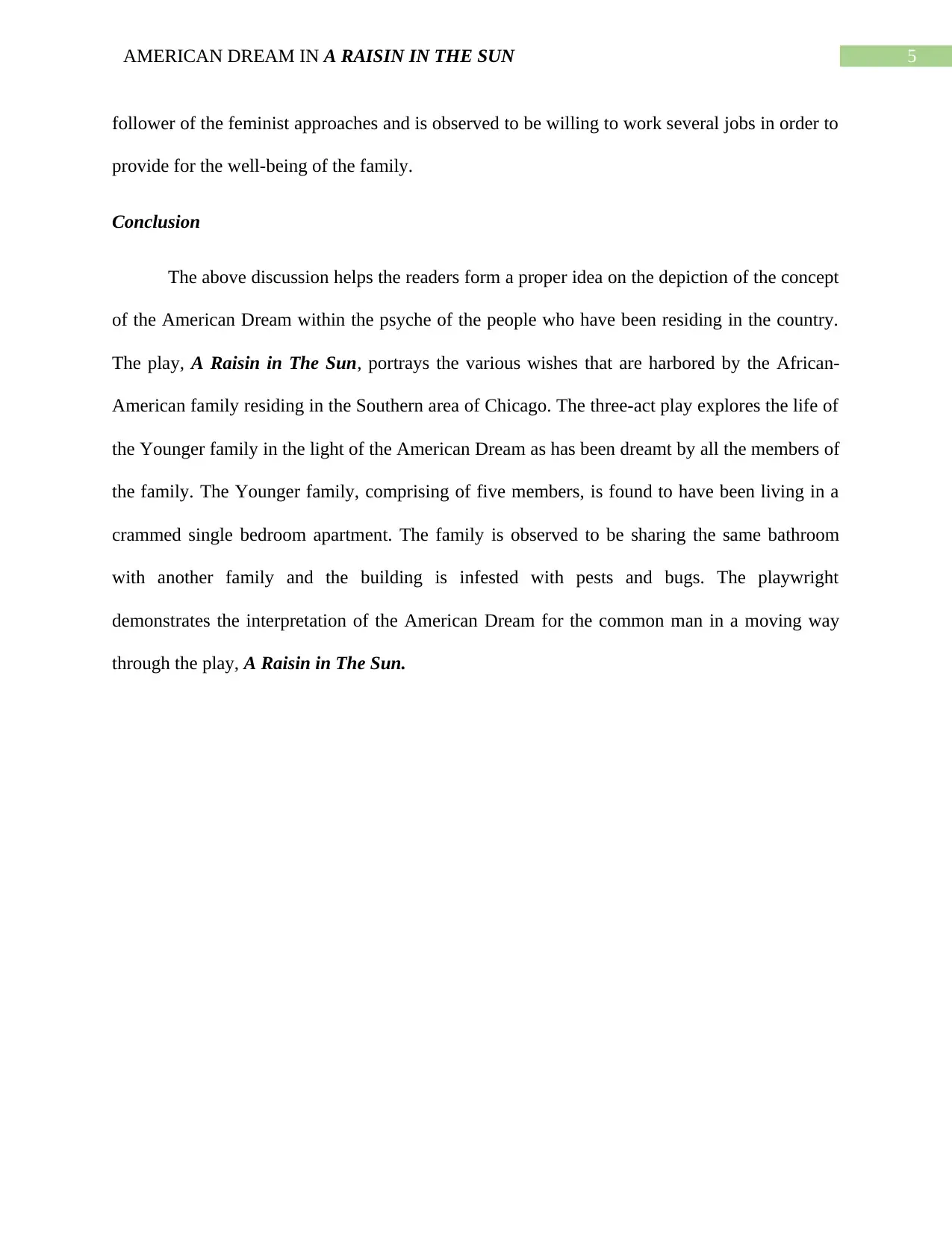
5AMERICAN DREAM IN A RAISIN IN THE SUN
follower of the feminist approaches and is observed to be willing to work several jobs in order to
provide for the well-being of the family.
Conclusion
The above discussion helps the readers form a proper idea on the depiction of the concept
of the American Dream within the psyche of the people who have been residing in the country.
The play, A Raisin in The Sun, portrays the various wishes that are harbored by the African-
American family residing in the Southern area of Chicago. The three-act play explores the life of
the Younger family in the light of the American Dream as has been dreamt by all the members of
the family. The Younger family, comprising of five members, is found to have been living in a
crammed single bedroom apartment. The family is observed to be sharing the same bathroom
with another family and the building is infested with pests and bugs. The playwright
demonstrates the interpretation of the American Dream for the common man in a moving way
through the play, A Raisin in The Sun.
follower of the feminist approaches and is observed to be willing to work several jobs in order to
provide for the well-being of the family.
Conclusion
The above discussion helps the readers form a proper idea on the depiction of the concept
of the American Dream within the psyche of the people who have been residing in the country.
The play, A Raisin in The Sun, portrays the various wishes that are harbored by the African-
American family residing in the Southern area of Chicago. The three-act play explores the life of
the Younger family in the light of the American Dream as has been dreamt by all the members of
the family. The Younger family, comprising of five members, is found to have been living in a
crammed single bedroom apartment. The family is observed to be sharing the same bathroom
with another family and the building is infested with pests and bugs. The playwright
demonstrates the interpretation of the American Dream for the common man in a moving way
through the play, A Raisin in The Sun.
⊘ This is a preview!⊘
Do you want full access?
Subscribe today to unlock all pages.

Trusted by 1+ million students worldwide
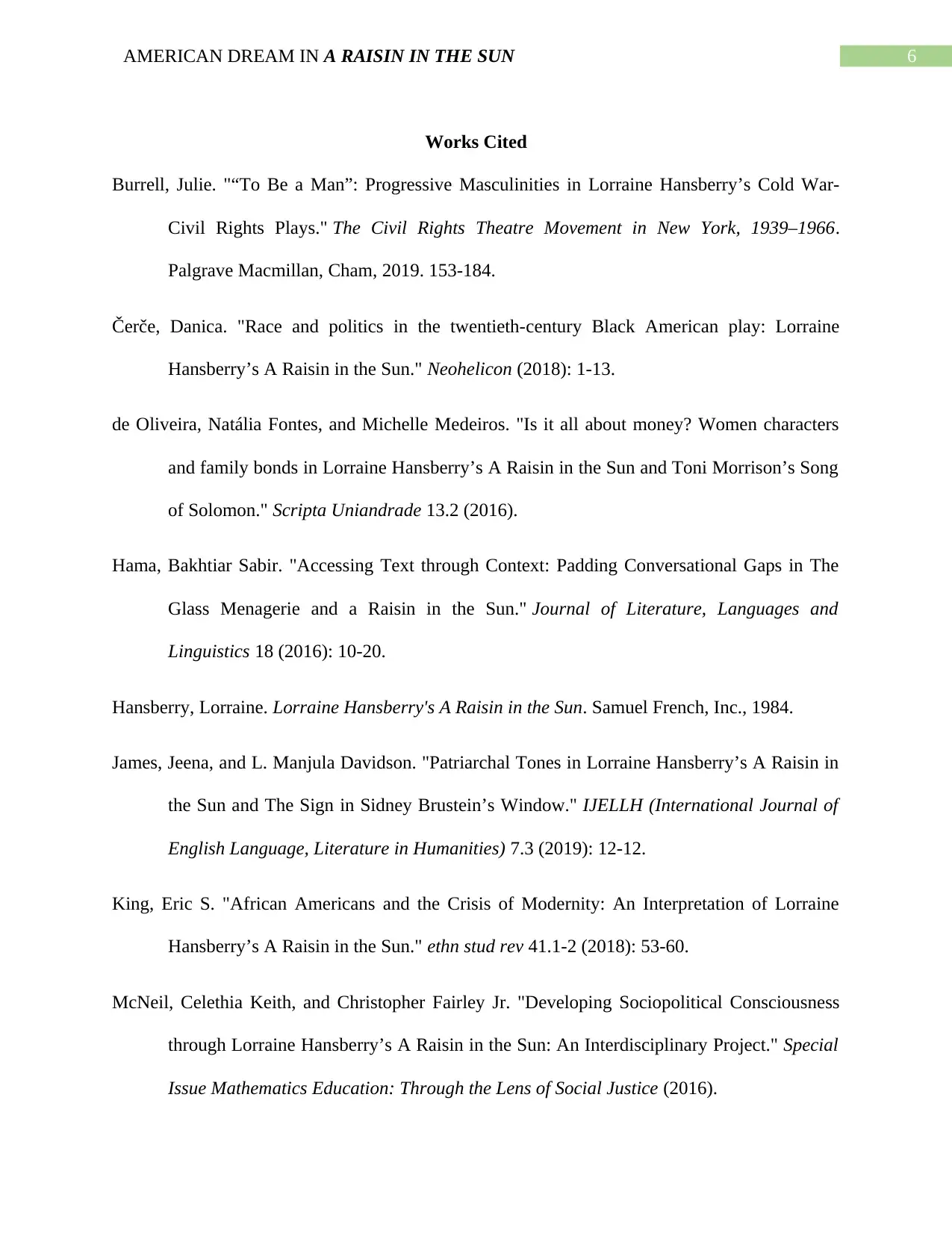
6AMERICAN DREAM IN A RAISIN IN THE SUN
Works Cited
Burrell, Julie. "“To Be a Man”: Progressive Masculinities in Lorraine Hansberry’s Cold War-
Civil Rights Plays." The Civil Rights Theatre Movement in New York, 1939–1966.
Palgrave Macmillan, Cham, 2019. 153-184.
Čerče, Danica. "Race and politics in the twentieth-century Black American play: Lorraine
Hansberry’s A Raisin in the Sun." Neohelicon (2018): 1-13.
de Oliveira, Natália Fontes, and Michelle Medeiros. "Is it all about money? Women characters
and family bonds in Lorraine Hansberry’s A Raisin in the Sun and Toni Morrison’s Song
of Solomon." Scripta Uniandrade 13.2 (2016).
Hama, Bakhtiar Sabir. "Accessing Text through Context: Padding Conversational Gaps in The
Glass Menagerie and a Raisin in the Sun." Journal of Literature, Languages and
Linguistics 18 (2016): 10-20.
Hansberry, Lorraine. Lorraine Hansberry's A Raisin in the Sun. Samuel French, Inc., 1984.
James, Jeena, and L. Manjula Davidson. "Patriarchal Tones in Lorraine Hansberry’s A Raisin in
the Sun and The Sign in Sidney Brustein’s Window." IJELLH (International Journal of
English Language, Literature in Humanities) 7.3 (2019): 12-12.
King, Eric S. "African Americans and the Crisis of Modernity: An Interpretation of Lorraine
Hansberry’s A Raisin in the Sun." ethn stud rev 41.1-2 (2018): 53-60.
McNeil, Celethia Keith, and Christopher Fairley Jr. "Developing Sociopolitical Consciousness
through Lorraine Hansberry’s A Raisin in the Sun: An Interdisciplinary Project." Special
Issue Mathematics Education: Through the Lens of Social Justice (2016).
Works Cited
Burrell, Julie. "“To Be a Man”: Progressive Masculinities in Lorraine Hansberry’s Cold War-
Civil Rights Plays." The Civil Rights Theatre Movement in New York, 1939–1966.
Palgrave Macmillan, Cham, 2019. 153-184.
Čerče, Danica. "Race and politics in the twentieth-century Black American play: Lorraine
Hansberry’s A Raisin in the Sun." Neohelicon (2018): 1-13.
de Oliveira, Natália Fontes, and Michelle Medeiros. "Is it all about money? Women characters
and family bonds in Lorraine Hansberry’s A Raisin in the Sun and Toni Morrison’s Song
of Solomon." Scripta Uniandrade 13.2 (2016).
Hama, Bakhtiar Sabir. "Accessing Text through Context: Padding Conversational Gaps in The
Glass Menagerie and a Raisin in the Sun." Journal of Literature, Languages and
Linguistics 18 (2016): 10-20.
Hansberry, Lorraine. Lorraine Hansberry's A Raisin in the Sun. Samuel French, Inc., 1984.
James, Jeena, and L. Manjula Davidson. "Patriarchal Tones in Lorraine Hansberry’s A Raisin in
the Sun and The Sign in Sidney Brustein’s Window." IJELLH (International Journal of
English Language, Literature in Humanities) 7.3 (2019): 12-12.
King, Eric S. "African Americans and the Crisis of Modernity: An Interpretation of Lorraine
Hansberry’s A Raisin in the Sun." ethn stud rev 41.1-2 (2018): 53-60.
McNeil, Celethia Keith, and Christopher Fairley Jr. "Developing Sociopolitical Consciousness
through Lorraine Hansberry’s A Raisin in the Sun: An Interdisciplinary Project." Special
Issue Mathematics Education: Through the Lens of Social Justice (2016).
Paraphrase This Document
Need a fresh take? Get an instant paraphrase of this document with our AI Paraphraser
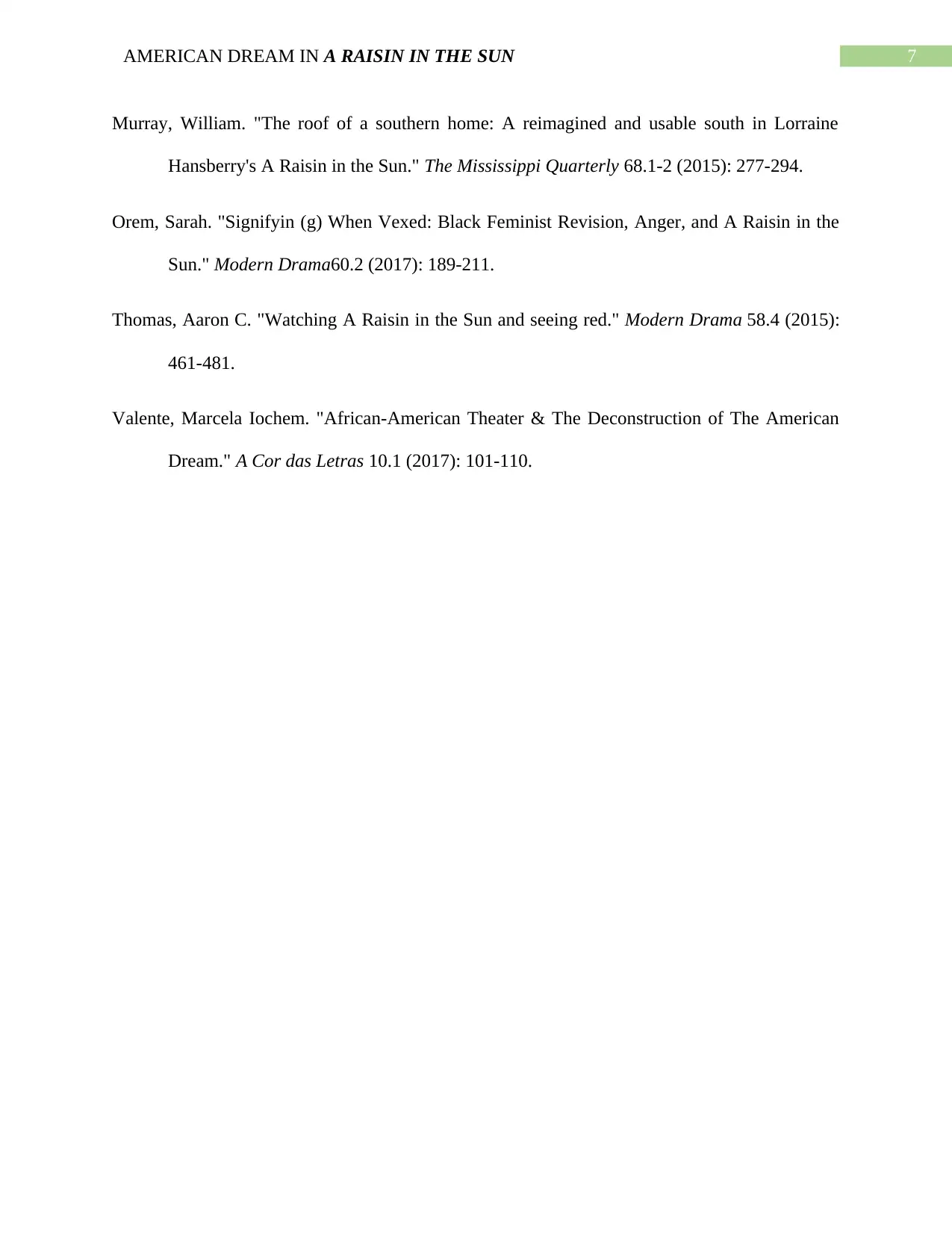
7AMERICAN DREAM IN A RAISIN IN THE SUN
Murray, William. "The roof of a southern home: A reimagined and usable south in Lorraine
Hansberry's A Raisin in the Sun." The Mississippi Quarterly 68.1-2 (2015): 277-294.
Orem, Sarah. "Signifyin (g) When Vexed: Black Feminist Revision, Anger, and A Raisin in the
Sun." Modern Drama60.2 (2017): 189-211.
Thomas, Aaron C. "Watching A Raisin in the Sun and seeing red." Modern Drama 58.4 (2015):
461-481.
Valente, Marcela Iochem. "African-American Theater & The Deconstruction of The American
Dream." A Cor das Letras 10.1 (2017): 101-110.
Murray, William. "The roof of a southern home: A reimagined and usable south in Lorraine
Hansberry's A Raisin in the Sun." The Mississippi Quarterly 68.1-2 (2015): 277-294.
Orem, Sarah. "Signifyin (g) When Vexed: Black Feminist Revision, Anger, and A Raisin in the
Sun." Modern Drama60.2 (2017): 189-211.
Thomas, Aaron C. "Watching A Raisin in the Sun and seeing red." Modern Drama 58.4 (2015):
461-481.
Valente, Marcela Iochem. "African-American Theater & The Deconstruction of The American
Dream." A Cor das Letras 10.1 (2017): 101-110.
1 out of 8
Your All-in-One AI-Powered Toolkit for Academic Success.
+13062052269
info@desklib.com
Available 24*7 on WhatsApp / Email
![[object Object]](/_next/static/media/star-bottom.7253800d.svg)
Unlock your academic potential
Copyright © 2020–2026 A2Z Services. All Rights Reserved. Developed and managed by ZUCOL.


